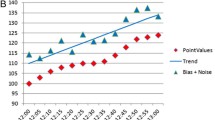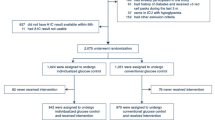Abstract
The traditional “Sliding Scale” is an inefficient and unreliable way of controlling blood glucose levels in ill patients receiving nutritional support in the Intensive Care Unit. In these patients, it is necessary to reassess insulin requirements frequently in the light of changing clinical circumstances. A significant improvement in control can be achieved by using a dynamic scale of instructions for changing the insulin dose rather than one of arbitrary dose levels. This scale adapts to any changes that occur without needing to be rewritten. It avoids confusion due to a proliferation of prescription charts, and has been readily accepted by nursing staff.
Similar content being viewed by others
References
Allison SP, Hinton P, Chamberlain MJ (1968) Intravenous glucose tolerance, insulin and free fatty acid levels in burned patients. Lancet 2:1113
Allison SP, Chamberlain MJ, Hinton P (1969) Intravenous glucose tolerance, insulin, glucose and free fatty acid levels after myocardial infarction. Br Med J 4:776
Allison SP, Morley CJ, Burns-Cox CJ (1972) Insulin, glucose and potassium in the treatment of congestive heart failure. Br Med J 3:675
Burn J, Williams WDC (1978) The effects of insulin glucose administration in fulminant hepatic failure. Intens Care Med 4:133
Hill GL, Blackett RL, Pickford I et al. (1977) Malnutrition in surgical patients. Lancet 1:767
Hinton P, Allison SP, Littlejohn S, Lloyd J (1973) Electrolyte changes after burn injury and effect of treatment. Lancet 2:218
Howard JM (1955) Studies on the absorption and metabolism of glucose following injury. Ann Surg 141:321
Lawson LJ (1965) Parenteral nutrition in surgery. Br J Surg 52:795
McWilliam DB (1980) The practical management of glucose-insulin infusions in the intensive care patient. Intens Care Med 6:133
Page MMcB, Alberti KGMM, Greenwood R et al. (1974) Treatment of diabetic coma with continuous low-dose infusion of insulin. Br Med J 2:687
Pindyck F, Drucker MR, Brown RS, Shoemaker WC (1974) Cardiorespiratory effects of hypertonic glucose in the critically ill patient. Surgery 75:11
Woolfson AMJ (1979) Metabolic considerations in nutritional support. Research and Clinical Forums 1:35
Woolfson AMJ, Heatley RV, Allison SP (1979) Insulin to inhibit protein catabolism after injury. New Engl J Med 300:14
Author information
Authors and Affiliations
Rights and permissions
About this article
Cite this article
Woolfson, A.M.J. Control of blood glucose during nutritional support in Ill patients. Intensive Care Med 7, 11–14 (1980). https://doi.org/10.1007/BF01692915
Issue Date:
DOI: https://doi.org/10.1007/BF01692915




